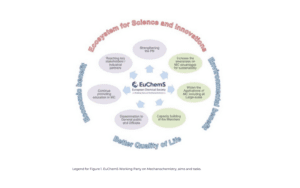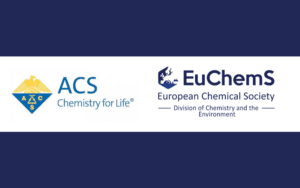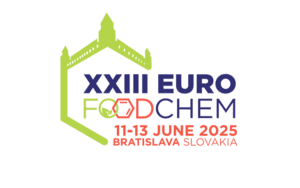The chamber of the laboratory, containing centuries old lab equipment, was filled with lively chatter on the afternoon of 29 March 2023. What used to be the working space of Justus Liebig, and his disciples from all around the world, now hosted students, historians, politicians, and international representatives of European Chemistry. These esteemed guests came here to celebrate the recognition of the laboratory as a EuChemS Historical Landmark.
This award identifies chemical sites where events that have played a vital role in defining the imprint of chemistry in the history of Europe occurred. Such sites are awarded a plaque which helps visitors learn about discoveries and breakthroughs of the past. In addition, the award links all EuChemS Landmarks, creating a network of historically significant chemical sites all over Europe and strengthening the sense of belonging in European chemists.

A European history
Liebig’s laboratory in Giessen was the first ever university research laboratory. Wide-ranging networks of communication, specialist journalism, science popularisation and science-based policy advice started from there. Liebig was a truly European figure, who made the small town the center of the chemical world for the 28 years of his stay. From there, he controlled the key print media of chemistry, such as multi-volume chemistry handbooks, the central refereeing yearbook of the time, and “Annalen der Chemie”, which soon became the leading chemical journal in Europe. Liebig was extremely successful in popularising chemistry and scientific education. His Chemical Letters of 1844 are perhaps the most successful popular chemistry books of all time, testified by numerous editions in 10 languages. From 1835, a steadily growing number of students came to study under Liebig: some 700 in total, plus 30 visiting scholars – the latter was unique for a German university at that time. His 83 international students came from all across the globe, as far as the Americas. Liebig’s connections with England were particularly strong. He established close contacts with British scientists, industrialists and farmers. In 1845, the Royal College of Chemistry was founded in London based on the Giessen model, and by 1865, almost all newly created professorships in chemistry at British universities, colleges and teaching hospitals were filled by former students of Liebig.
Thus, Liebig’s Giessen laboratory is a place whose significance extends far beyond disciplinary and geographical boundaries, pointing us to the origins of the modern knowledge society and to the international nature of science.
In recognition of its role in the history of chemistry, the German Chemical Society (GDCh) has included the building in its programme Historische Stätten der Chemie in 2003.
Preserving the legacy
The EuChemS Landmark Award, while celebrating the above discussed historical significance, also aims to recognise how this legacy is handled. The excellent use of this site to preserve the role of the discipline of chemistry as a part of European history is the achievement of the enthusiastic members of the Liebig Society.
While the Justus Liebig Society is a separate registered association from the Justus Liebig University of Giessen, it is closely connected to it in terms of personnel and organisation. As a private-law holder of the museum, the society is financed exclusively by member contributions, entrance fees, rents, and above all, donations. The Justus Liebig Society currently has 370 members, of which 26 are companies or societies. The society, which runs the Museum since 1920, is currently preparing a proposal for qualifying as a candidate for the UNESCO World Heritage List. If successful, it would be the first example of a science site in the list. With this goal in mind, the Museum has made enormous efforts in the past few years.

Luck and misfortune, intertwined
The first part of the award ceremony was kindly hosted by the neighbouring Mathematicum, which serves as a great display of cooperation between enthusiastic representatives of science. While initially, speeches were planned to be held in the historic lecture hall of Justus Liebig, sadly the hall suffered fire damage in late 2022. Yet, this unfortunate event shed light on the solidarity of the community. After the fire in the lecture hall on December 5, the soot damage in the laboratories and the library was quickly repaired. In the meantime, the first cost estimates became available, and a modern heating system is being installed. The Liebig Society sees this fire as an opportunity to make urgently needed improvements to fire protection, electrical installations as well as energy-related insulation refurbishment. Individuals, businesses and public agencies are raising the funds.
All in all, the Liebig Museum is to be substantially improved technically and structurally to remain fit for the next decades. The great commitment and high level of competence of the volunteers and the distribution of the diverse and challenging work on many shoulders gives the Liebig Society very positive outlook for the future.
In conclusion, the Justus Liebig Laboratory represents the values of pioneering truly international and versatile research, acknowledged by the Historical Landmark Award, testifying as the history of chemistry is shaped by inclusion and communication across national boundaries.



